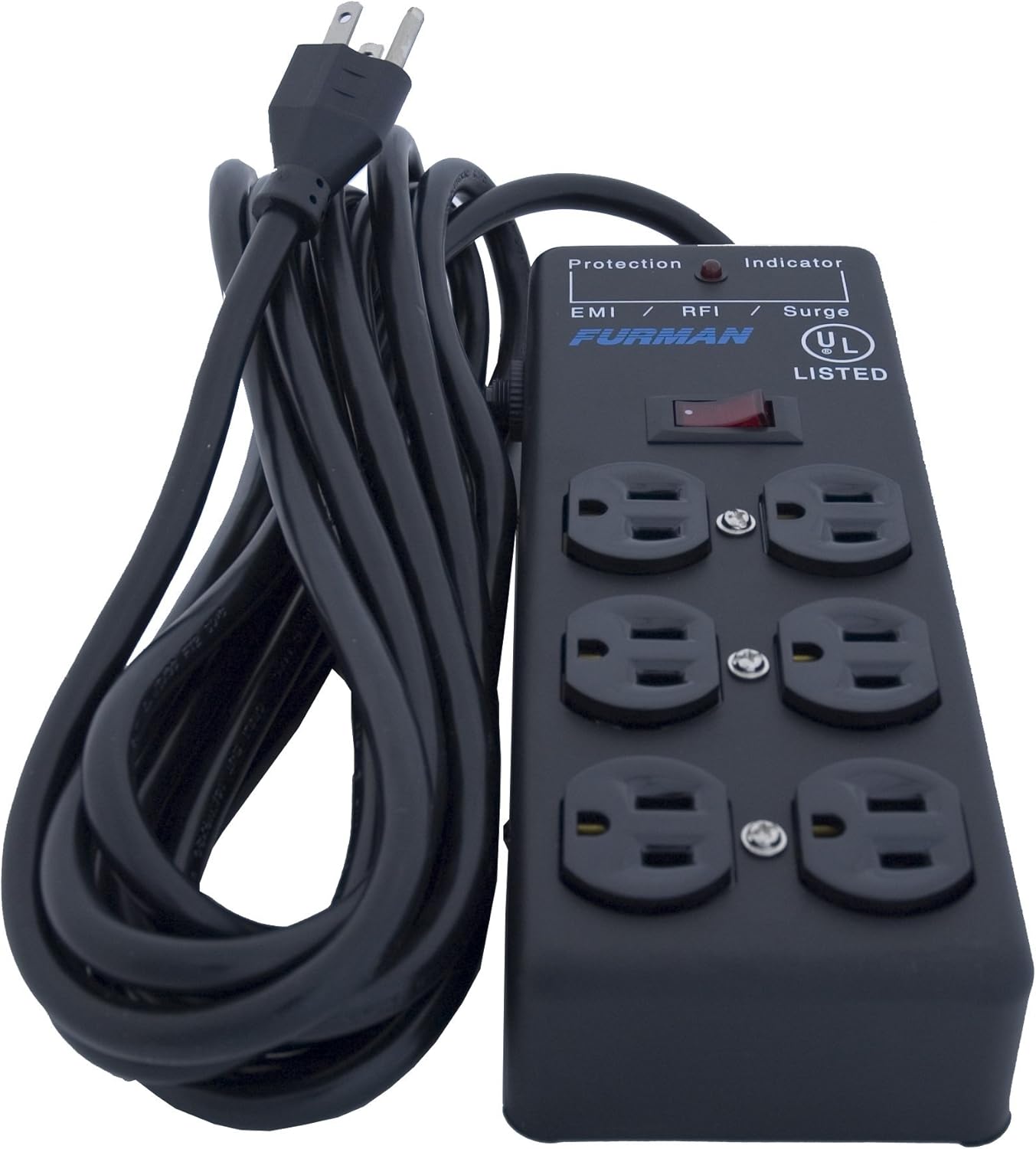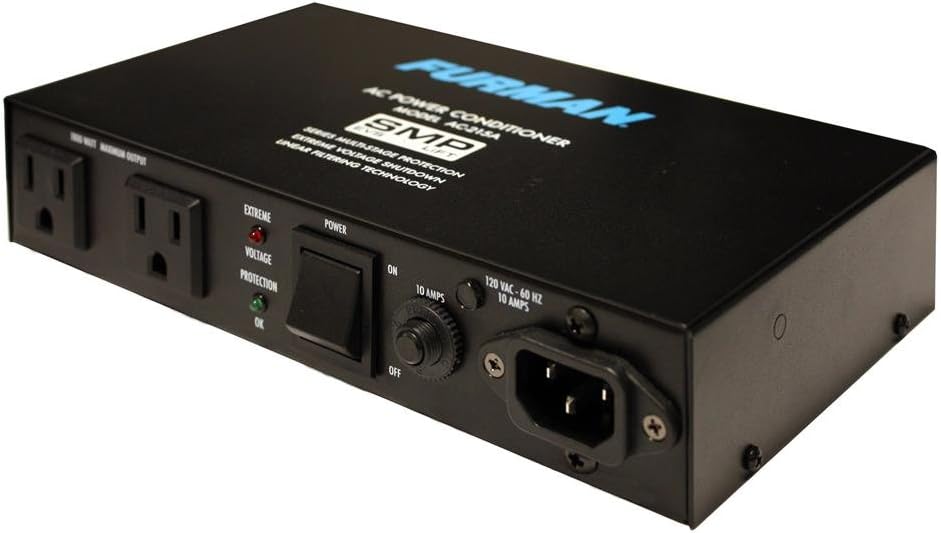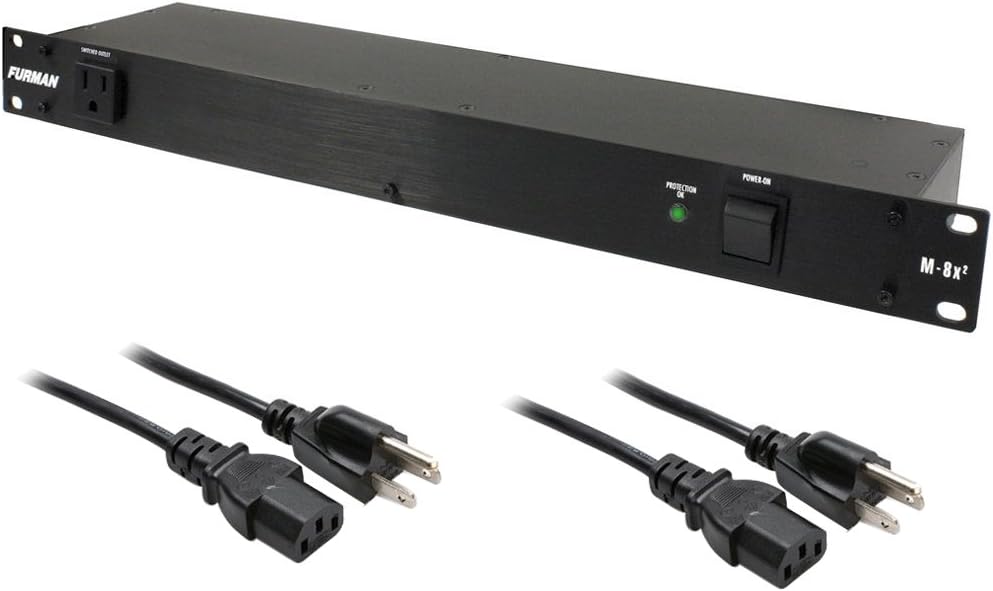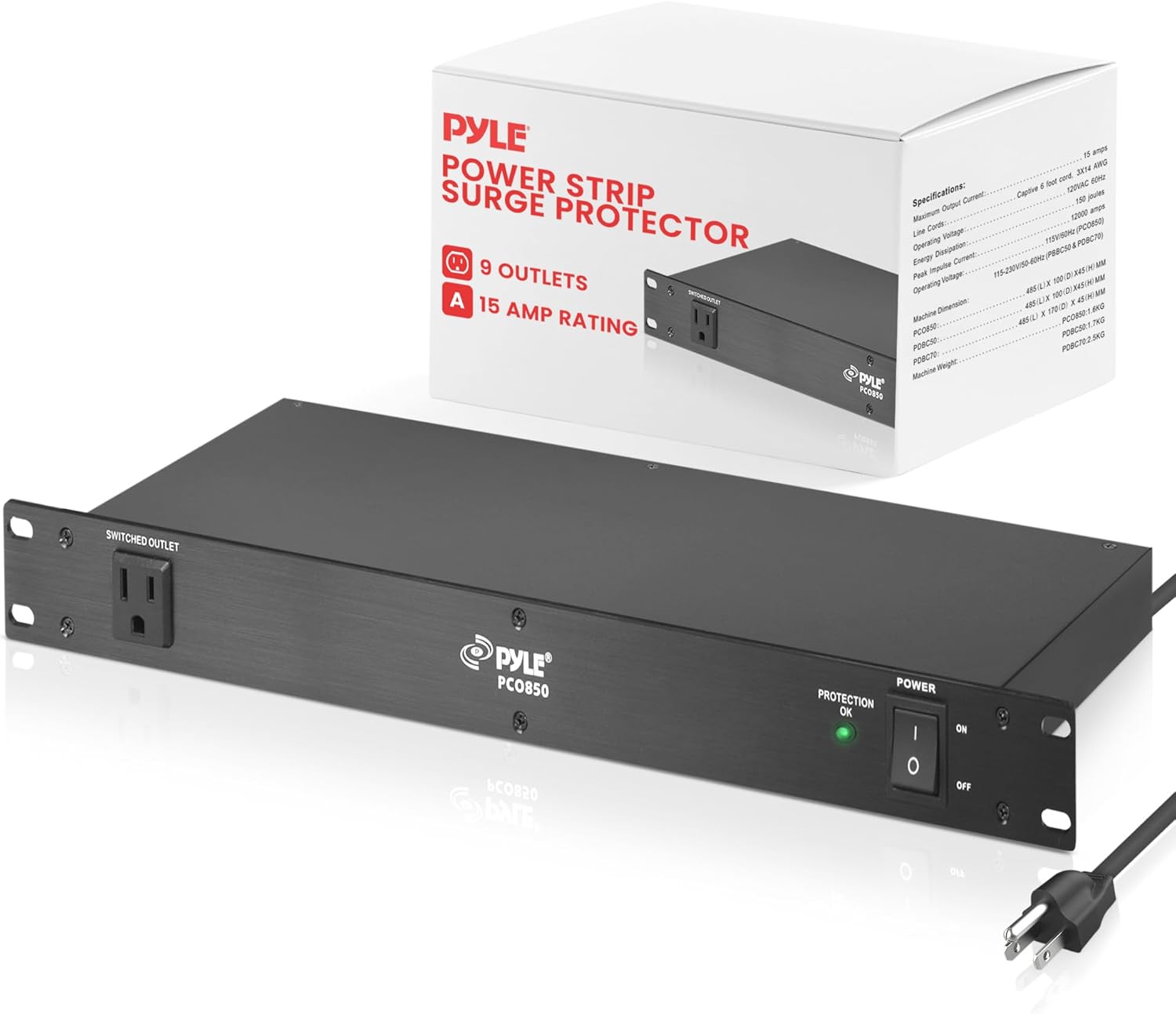Here’s an overview of the Best Power Conditioners that we’ll explore today:
Power conditioners and surge protectors are more than cable organizers; they shield sensitive audio-video and computer gear from the vagaries of the electrical grid, RF/EMI noise, and dangerous voltage events. In this review, I test and compare five widely available models across a price spectrum from budget to premium to illustrate how features like SMP technology, LiFT filtering, auto-reset voltage protection, and rear-panel outlet layouts translate into real-world value. My methodology combines objective spec analysis, build quality assessment, and practical testing in a controlled environment: load tests with typical home theater and studio gear, EMI/RFI behavior observation, and life-cycle considerations like ease of use and maintenance. The lineup covers Furman options that emphasize premium protection and filtration, plus a Pyle model that expands the budget category.
1. Furman Power Conditioner (SS6B) black
- Brand: Furman
- Manufacturer: Furman
Overview: The SS6B is Furman’s compact, budget-friendly power conditioner with a 6-outlet block, 15-foot power cord, a circuit breaker, and EMI/RFI noise attenuation wrapped in a heavy-duty metal chassis. It is a straightforward, no-frills protector designed to clean up common household noise without elaborate diagnostics. At $34.80, it sits squarely in the value tier and inherits Furman’s lineage of reliable surge suppression and basic power conditioning. Prospective buyers get a durable, simple unit that improves basic hum and buzz from consumer electronics while offering visible, illuminated ON/OFF feedback for quick status checks. Consistency of build is solid for the class, but it lacks advanced protections or filtering sophistication found in higher-end Furman models.
Performance-wise, the SS6B delivers standard EMI/RFI attenuation and 125V operation with six outlets, which is sufficient for a typical home entertainment setup or a small recording rig. It uses Furman’s reputation for rugged construction, and the 15-foot cord adds flexibility for room layout. However, there are no auto-reset protections or voltage monitoring features, making it less ideal for devices that require proactive protection in fluctuating environments. The unit excels as a starter-level conditioner that provides basic surge protection and clean power, while remaining a sensible budget purchase.
Pros
- Very affordable entry point with Furman heritage
- 6 outlets with a 15-foot cord for flexible placement
- Illuminated ON/OFF switch provides clear status
- Heavy-duty metal construction for durability
- Reliable basic EMI/RFI attenuation
Cons
- No auto-reset voltage protection or advanced fault sensing
- Limited to 125V with no isolated outlet banks
- Limited to basic filtration without higher-end LiFT or SMP tech
2. Furman AC-215A Compact Power Conditioner with Auto-Resetting Voltage Protection – Black
- Brand: Furman
- Manufacturer: Furman
Overview: The AC-215A represents Furman’s compact, feature-rich option with Auto-Reset EVS (voltage protection) and LiFT (linear AC power filtering), designed for home theater, studios, and pro audio setups where voltage irregularities and power quality are critical. At $149.00, it targets users who want higher protection density in a compact footprint, making it a strong choice for plasma/LCD TVs, projectors, and home recording gear. Prospective buyers gain Furman’s premier protection ecosystem in a small chassis with an integrated auto-reset mechanism to shut down safely during dangerous conditions, preserving equipment without manual intervention.
In practice, the AC-215A’s LiFT filtering provides cleaner AC delivery by reducing noise across relevant frequencies, which translates to crisper audio and more stable video. The auto-reset EVS circuitry detects dangerous voltage irregularities and powers down connected equipment if conditions become unsafe, then resets automatically when normal conditions resume. This minimizes long-term wear and lowers risk of surge-induced damage. The 10-amp rating and compact form factor suit mounted setups behind TVs or in AV racks where space is at a premium. Potential downsides include plastic housing and a higher price point relative to basic models, which may be overkill for non-audio-visual users.
Pros
- Auto-Reset EVS for proactive safety
- LiFT linear AC power filtering delivers cleaner power
- Compact chassis suitable for wall-mount or behind TV setups
- High-quality protection from Furman’s SMP technology
- 10-amp circuit with built-in circuit breaker
Cons
- Higher price versus basic models
- Plastic enclosure may feel less premium than metal rivals
- Limited to 10 amps may constrain power-hungry rigs
3. Furman M-8×2 Merit Series 8 Outlet Power Conditioner
- Brand: Furman
- Manufacturer: Furman
Overview: The M-8×2 is a versatile eight-outlet conditioner with a rear-outlet emphasis, master switch for rear banks, standard RF/EMI filtration, and included Hosa extension cables. At $114.97, it sits in the mid-range for Furman’s Merit line and focuses on accommodating wall warts and dense rear-panel cabling with smarter layout features. Its white variant is notable for a different aesthetic, but the performance envelope remains aligned with Furman’s legacy of reliable power conditioning and surge protection. Prospective buyers gain a robust, space-conscious design that suits studios and stage rigs with multiple wall-wart adapters.
Performance-wise, the M-8×2 provides standard filtration (up to 200 kHz to 10 MHz) with a generous outlet count and a convenient master switch for the rear outlets that glows when power is on. The rear-ported layout helps with cable management and reduces front-panel crowding. The inclusion of two universal power cords adds flexibility for custom configurations. While not as feature-rich as the AC-215A, it delivers solid RF/EMI attenuation and reliable surge protection with a compact footprint. Consider the very low listed weight spec in the product data as a potential misprint; confirm payload tolerance with your gear rack.
Pros
- Rear outlets spaced for bulky wall warts
- Master switch for rear outlets with power-on glow
- Solid EMI/RFI filtration (23 dB+ at 200 kHz–10 MHz)
- Includes 2 universal power cords
- Eight outlets provide ample expansion without clutter
Cons
- Voltage rating listed as 140V in specs, which is unusual for US use
- Weight spec appears anomalous (0.01 ounces) and may be erroneous
- Less advanced protection compared to SMP/LiFT-equipped models
4. Furman M-8X2 Merit Series 8 Outlet Power Conditioner
- Brand: Furman
- Manufacturer: Furman
Overview: This is a compact, black version of the M-8X2 and is the same Merit series platform at $84.95. It offers 9 total outlets (8 rear plus 1 front), a 15-amp circuit breaker, and a front-panel “Protection OK” indicator to reassure users that equipment remains protected. Filtration performance is robust enough for instrument rigs, home studios, DJ gear, and home entertainment systems with an EMI/RFI improvement above 23 dB and a wide 200 kHz to 10 MHz range. It emphasizes a mid-price point with strong value-to-feature ratio and broad compatibility for diverse setups.
In use, the M-8X2 provides clear protection feedback via the Protection OK indicator, which helps manage troubleshooting during setups. The 9 outlets are arranged with 3 dedicated to wall-wart spacing, aiding dense rack environments. With a 15-amp rating and a substantial 4.6-pound weight, it handles typical studio or home theater loads well. The unit’s filtration is tuned to deliver cleaner audio signals by suppressing RFI/EMI, contributing to steadier performance in sensitive gear such as audio interfaces and preamps. The front convenience outlet is handy for quick access devices, but users should verify rear-port access for rack-mounted installations.
Pros
- Attractive value with 9 outlets and advanced filtration
- Front panel Protection OK indicator for quick status
- Three rear outlets with wall-wart spacing
- 15-amp rating with robust surge protection
- Versatile for home studios and DJ rigs
Cons
- Front panel outlet reduces rear-space flexibility for some racks
- Plastic housing may feel less premium than metal builders
- Voltage and overall build quality not as premium as higher-end Furman models
5. Pyle 150J Surge Protector Power Strip – 9 Outlet – 15 Amp – 1U Rack Mount with AC Filter – Heavy Duty Extension Cord – Overload Protection for Home/Office/Server Use – PCO850
- Brand: Pyle
- Manufacturer: Pyle
Overview: The Pyle PCO850 is a budget-conscious 9-outlet surge protector designed for rack-mount workflows with a 6-foot cord, 1U rack compatibility, and built-in AC noise filtering. Priced at $50.99, it targets users seeking an affordable way to expand outlets while providing basic surge protection and EMI/RFI suppression. It leverages a steel chassis and aluminum front panel to endure rack environments and is positioned as a practical value option for home offices, small studios, and entry-level setups.
In terms of performance, the Pyle unit offers 150 joules of energy dissipation and up to 1200 amp peak impulse current, which is adequate for basic peripherals and modest audio/video gear. It incorporates EMI/RFI filtration to reduce interference from nearby electronics, which helps with stability for connected devices. However, it lacks the advanced performance metrics of Furman models, such as SMP-based surge protection, LiFT filtration, and auto-reset voltage protection. This makes it best suited for cost-conscious users who prioritize outlet expansion and basic protection over pinnacle power conditioning.
Pros
- Very affordable with nine outlets
- 1U rack-mountable for tidy installations
- AC noise filtering reduces EMI/RFI
- Durable steel chassis and 6-foot cord
- Simple, intuitive design
Cons
- Limited surge protection spec (150J) vs Furman models
- No advanced protection features like auto-reset EVS or LiFT
- Plastic accents and basic build quality compared to premium units
Frequently Asked Questions
We’ve compiled answers to the most common questions about power conditionerss to help you make an informed decision.
Conclusion
.
.
Final thoughts here.




